Develop and Use Emotional Intelligence
VerifiedAdded on 2023/06/13
|18
|4851
|477
AI Summary
This article discusses the importance of emotional intelligence in the workplace and how to develop and use it to achieve organizational goals. It covers topics such as emotional strengths and weaknesses, emotional stresses, emotional triggers, emotional intelligence management, principles of emotional intelligence, misinterpretations of behavior, and the relationship between emotions and goal achievement. The article also provides tips on how to model positive leadership traits and promote efficient communication in a multicultural workplace.
Contribute Materials
Your contribution can guide someone’s learning journey. Share your
documents today.
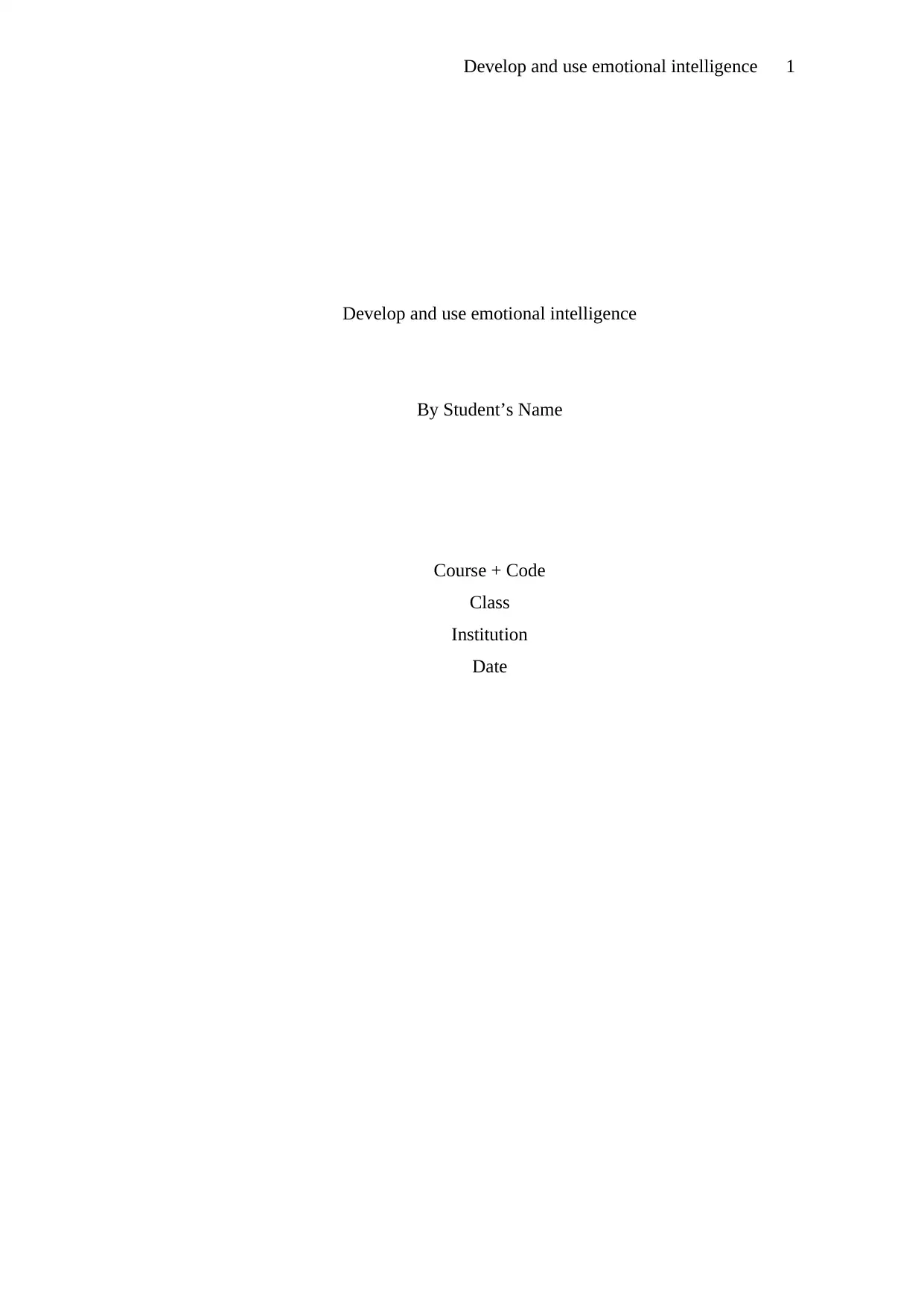
Develop and use emotional intelligence 1
Develop and use emotional intelligence
By Student’s Name
Course + Code
Class
Institution
Date
Develop and use emotional intelligence
By Student’s Name
Course + Code
Class
Institution
Date
Secure Best Marks with AI Grader
Need help grading? Try our AI Grader for instant feedback on your assignments.
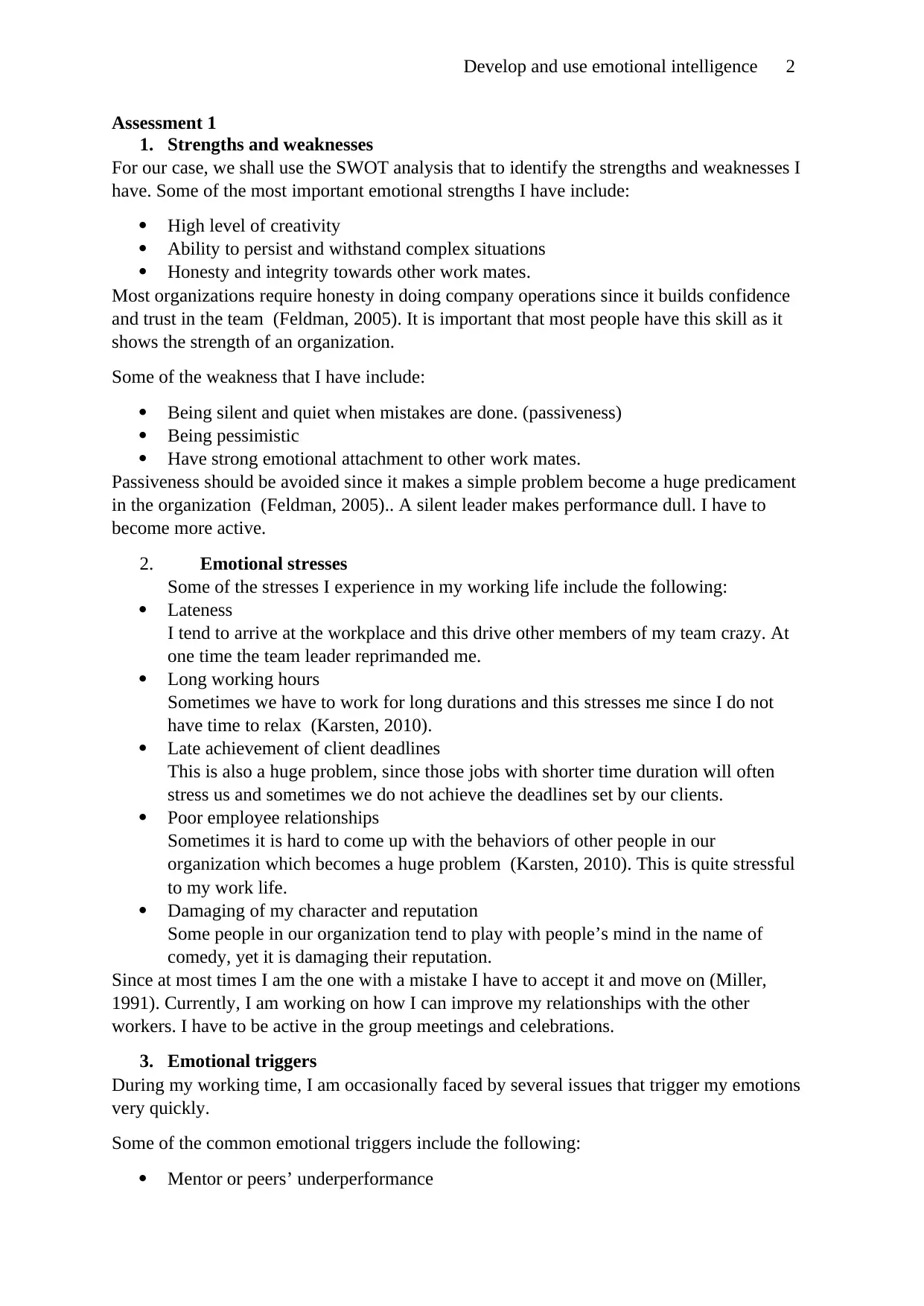
Develop and use emotional intelligence 2
Assessment 1
1. Strengths and weaknesses
For our case, we shall use the SWOT analysis that to identify the strengths and weaknesses I
have. Some of the most important emotional strengths I have include:
High level of creativity
Ability to persist and withstand complex situations
Honesty and integrity towards other work mates.
Most organizations require honesty in doing company operations since it builds confidence
and trust in the team (Feldman, 2005). It is important that most people have this skill as it
shows the strength of an organization.
Some of the weakness that I have include:
Being silent and quiet when mistakes are done. (passiveness)
Being pessimistic
Have strong emotional attachment to other work mates.
Passiveness should be avoided since it makes a simple problem become a huge predicament
in the organization (Feldman, 2005).. A silent leader makes performance dull. I have to
become more active.
2. Emotional stresses
Some of the stresses I experience in my working life include the following:
Lateness
I tend to arrive at the workplace and this drive other members of my team crazy. At
one time the team leader reprimanded me.
Long working hours
Sometimes we have to work for long durations and this stresses me since I do not
have time to relax (Karsten, 2010).
Late achievement of client deadlines
This is also a huge problem, since those jobs with shorter time duration will often
stress us and sometimes we do not achieve the deadlines set by our clients.
Poor employee relationships
Sometimes it is hard to come up with the behaviors of other people in our
organization which becomes a huge problem (Karsten, 2010). This is quite stressful
to my work life.
Damaging of my character and reputation
Some people in our organization tend to play with people’s mind in the name of
comedy, yet it is damaging their reputation.
Since at most times I am the one with a mistake I have to accept it and move on (Miller,
1991). Currently, I am working on how I can improve my relationships with the other
workers. I have to be active in the group meetings and celebrations.
3. Emotional triggers
During my working time, I am occasionally faced by several issues that trigger my emotions
very quickly.
Some of the common emotional triggers include the following:
Mentor or peers’ underperformance
Assessment 1
1. Strengths and weaknesses
For our case, we shall use the SWOT analysis that to identify the strengths and weaknesses I
have. Some of the most important emotional strengths I have include:
High level of creativity
Ability to persist and withstand complex situations
Honesty and integrity towards other work mates.
Most organizations require honesty in doing company operations since it builds confidence
and trust in the team (Feldman, 2005). It is important that most people have this skill as it
shows the strength of an organization.
Some of the weakness that I have include:
Being silent and quiet when mistakes are done. (passiveness)
Being pessimistic
Have strong emotional attachment to other work mates.
Passiveness should be avoided since it makes a simple problem become a huge predicament
in the organization (Feldman, 2005).. A silent leader makes performance dull. I have to
become more active.
2. Emotional stresses
Some of the stresses I experience in my working life include the following:
Lateness
I tend to arrive at the workplace and this drive other members of my team crazy. At
one time the team leader reprimanded me.
Long working hours
Sometimes we have to work for long durations and this stresses me since I do not
have time to relax (Karsten, 2010).
Late achievement of client deadlines
This is also a huge problem, since those jobs with shorter time duration will often
stress us and sometimes we do not achieve the deadlines set by our clients.
Poor employee relationships
Sometimes it is hard to come up with the behaviors of other people in our
organization which becomes a huge problem (Karsten, 2010). This is quite stressful
to my work life.
Damaging of my character and reputation
Some people in our organization tend to play with people’s mind in the name of
comedy, yet it is damaging their reputation.
Since at most times I am the one with a mistake I have to accept it and move on (Miller,
1991). Currently, I am working on how I can improve my relationships with the other
workers. I have to be active in the group meetings and celebrations.
3. Emotional triggers
During my working time, I am occasionally faced by several issues that trigger my emotions
very quickly.
Some of the common emotional triggers include the following:
Mentor or peers’ underperformance

Develop and use emotional intelligence 3
Poor communication skills from some people
Silence from workmates when asked questions
The above trigger my emotions very quickly. I move away from unresponsive people to
avoid such disappointments (Miller, 1991). I also take the initiative to ensure that there is
improved performance. I always take myself responsible and accountable for the mistakes
that occur.
4. Emotional intelligence management
First and foremost, managing of some emotions may be difficult and thus people have to be
keen on how to manage some emotions. For instance, anger and frustration should be handled
delicately or else things may steam up (Claudia, 2018). Workers should be called upon to
discuss on their reactions and behaviors and not discuss the people they are frustrated to.
Consulting and counselling should be appropriate in dealing with such situations. The
management or the employee themselves must ensure that there are healthy relationships
among the people in the organization.
Emotions are different especially with different cultures. Different cultures have different
rules on how people should express their emotions (Claudia, 2018). Miscommunications in
the organizations may lead to various problems and even loss of healthy relationships.
Leaders should be keen on observing, empathizing, interpreting and ask questions about the
environment a person exists. This helps identify how those people express their emotions.
A good example of expressing emotions that may lead to tensions due to culture differences
is smiling to a team member (Miller, 1991). In Islam, smiling is regarded as an emotional
sexual gesture. A leader should be aware of these problems and even if possible address it.
Another example is disgust from those people who have allergies to certain food products and
thus create a totally different emotion tension. When interacting leaders should take into
account this differences since culture tensions may make communication inefficient.
5. Principles of emotional intelligence
For continuous development in an organization, then self-reflection is key. For me, I am able
to hold myself accountable for everything that happens and try to improve on them (Claudia,
2018). Through self-reflection, I am flexible to different environments and can work
efficiently. I can easily adjust to any environment I face. Some of the principles I have to put
to use that help improve emotional intelligence include the following:
Self- awareness
Being able to identify my own reactions, will help improve my emotional intelligence
so that I am not frustrated for the wrong reasons or happy during sad occasions.
Self-control
This is the ability to keep your emotions in check by either taking a deep breathe,
taking a stroll or conversing openly (Clarke, 2010). This helps improve my emotional
intelligence.
Adaptability
Life is dynamic with adjustments every day. I have to be ready to adapt to the
adjustments that may cause a disruption in my emotions (Clarke, 2010). Not getting
Poor communication skills from some people
Silence from workmates when asked questions
The above trigger my emotions very quickly. I move away from unresponsive people to
avoid such disappointments (Miller, 1991). I also take the initiative to ensure that there is
improved performance. I always take myself responsible and accountable for the mistakes
that occur.
4. Emotional intelligence management
First and foremost, managing of some emotions may be difficult and thus people have to be
keen on how to manage some emotions. For instance, anger and frustration should be handled
delicately or else things may steam up (Claudia, 2018). Workers should be called upon to
discuss on their reactions and behaviors and not discuss the people they are frustrated to.
Consulting and counselling should be appropriate in dealing with such situations. The
management or the employee themselves must ensure that there are healthy relationships
among the people in the organization.
Emotions are different especially with different cultures. Different cultures have different
rules on how people should express their emotions (Claudia, 2018). Miscommunications in
the organizations may lead to various problems and even loss of healthy relationships.
Leaders should be keen on observing, empathizing, interpreting and ask questions about the
environment a person exists. This helps identify how those people express their emotions.
A good example of expressing emotions that may lead to tensions due to culture differences
is smiling to a team member (Miller, 1991). In Islam, smiling is regarded as an emotional
sexual gesture. A leader should be aware of these problems and even if possible address it.
Another example is disgust from those people who have allergies to certain food products and
thus create a totally different emotion tension. When interacting leaders should take into
account this differences since culture tensions may make communication inefficient.
5. Principles of emotional intelligence
For continuous development in an organization, then self-reflection is key. For me, I am able
to hold myself accountable for everything that happens and try to improve on them (Claudia,
2018). Through self-reflection, I am flexible to different environments and can work
efficiently. I can easily adjust to any environment I face. Some of the principles I have to put
to use that help improve emotional intelligence include the following:
Self- awareness
Being able to identify my own reactions, will help improve my emotional intelligence
so that I am not frustrated for the wrong reasons or happy during sad occasions.
Self-control
This is the ability to keep your emotions in check by either taking a deep breathe,
taking a stroll or conversing openly (Clarke, 2010). This helps improve my emotional
intelligence.
Adaptability
Life is dynamic with adjustments every day. I have to be ready to adapt to the
adjustments that may cause a disruption in my emotions (Clarke, 2010). Not getting
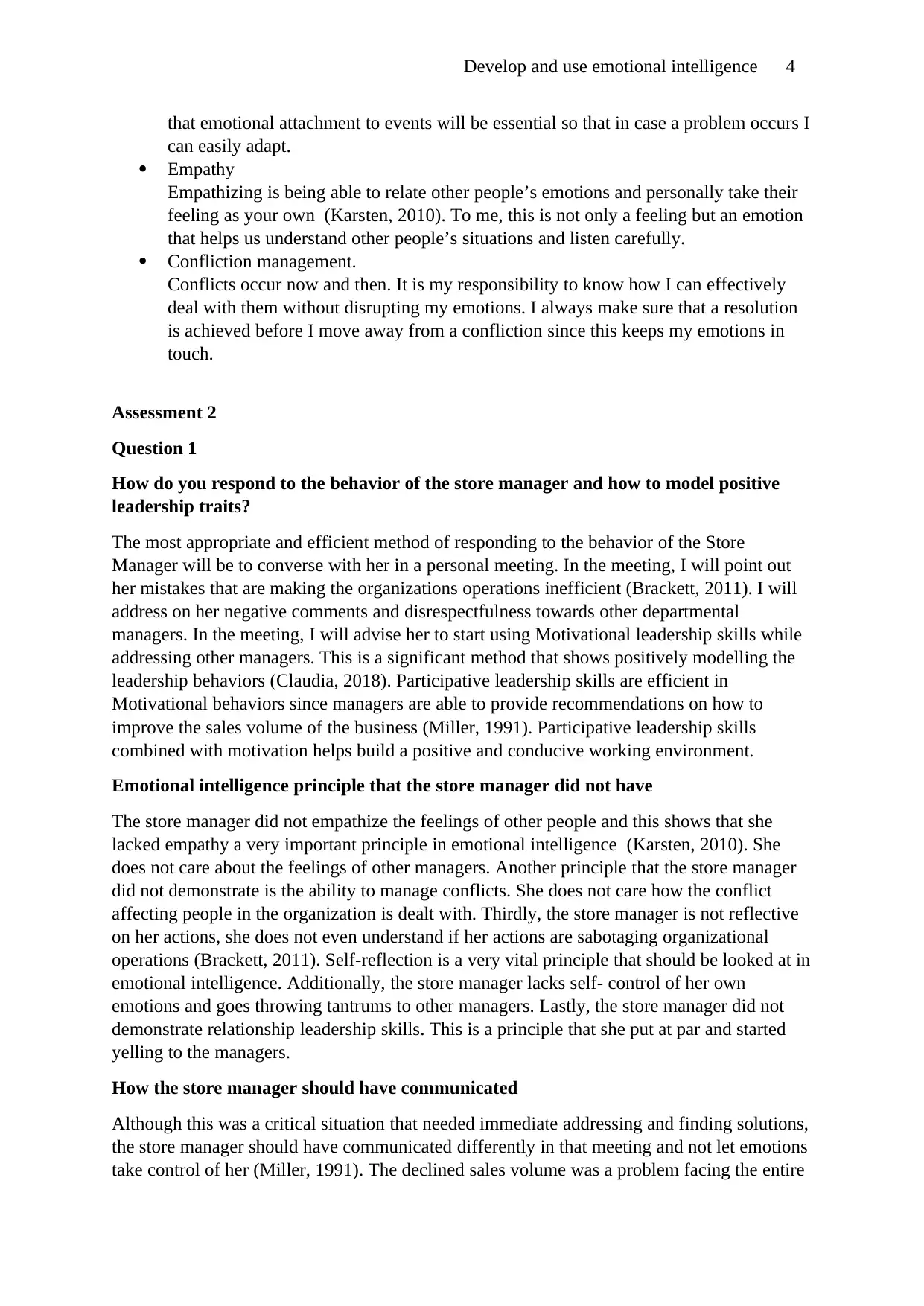
Develop and use emotional intelligence 4
that emotional attachment to events will be essential so that in case a problem occurs I
can easily adapt.
Empathy
Empathizing is being able to relate other people’s emotions and personally take their
feeling as your own (Karsten, 2010). To me, this is not only a feeling but an emotion
that helps us understand other people’s situations and listen carefully.
Confliction management.
Conflicts occur now and then. It is my responsibility to know how I can effectively
deal with them without disrupting my emotions. I always make sure that a resolution
is achieved before I move away from a confliction since this keeps my emotions in
touch.
Assessment 2
Question 1
How do you respond to the behavior of the store manager and how to model positive
leadership traits?
The most appropriate and efficient method of responding to the behavior of the Store
Manager will be to converse with her in a personal meeting. In the meeting, I will point out
her mistakes that are making the organizations operations inefficient (Brackett, 2011). I will
address on her negative comments and disrespectfulness towards other departmental
managers. In the meeting, I will advise her to start using Motivational leadership skills while
addressing other managers. This is a significant method that shows positively modelling the
leadership behaviors (Claudia, 2018). Participative leadership skills are efficient in
Motivational behaviors since managers are able to provide recommendations on how to
improve the sales volume of the business (Miller, 1991). Participative leadership skills
combined with motivation helps build a positive and conducive working environment.
Emotional intelligence principle that the store manager did not have
The store manager did not empathize the feelings of other people and this shows that she
lacked empathy a very important principle in emotional intelligence (Karsten, 2010). She
does not care about the feelings of other managers. Another principle that the store manager
did not demonstrate is the ability to manage conflicts. She does not care how the conflict
affecting people in the organization is dealt with. Thirdly, the store manager is not reflective
on her actions, she does not even understand if her actions are sabotaging organizational
operations (Brackett, 2011). Self-reflection is a very vital principle that should be looked at in
emotional intelligence. Additionally, the store manager lacks self- control of her own
emotions and goes throwing tantrums to other managers. Lastly, the store manager did not
demonstrate relationship leadership skills. This is a principle that she put at par and started
yelling to the managers.
How the store manager should have communicated
Although this was a critical situation that needed immediate addressing and finding solutions,
the store manager should have communicated differently in that meeting and not let emotions
take control of her (Miller, 1991). The declined sales volume was a problem facing the entire
that emotional attachment to events will be essential so that in case a problem occurs I
can easily adapt.
Empathy
Empathizing is being able to relate other people’s emotions and personally take their
feeling as your own (Karsten, 2010). To me, this is not only a feeling but an emotion
that helps us understand other people’s situations and listen carefully.
Confliction management.
Conflicts occur now and then. It is my responsibility to know how I can effectively
deal with them without disrupting my emotions. I always make sure that a resolution
is achieved before I move away from a confliction since this keeps my emotions in
touch.
Assessment 2
Question 1
How do you respond to the behavior of the store manager and how to model positive
leadership traits?
The most appropriate and efficient method of responding to the behavior of the Store
Manager will be to converse with her in a personal meeting. In the meeting, I will point out
her mistakes that are making the organizations operations inefficient (Brackett, 2011). I will
address on her negative comments and disrespectfulness towards other departmental
managers. In the meeting, I will advise her to start using Motivational leadership skills while
addressing other managers. This is a significant method that shows positively modelling the
leadership behaviors (Claudia, 2018). Participative leadership skills are efficient in
Motivational behaviors since managers are able to provide recommendations on how to
improve the sales volume of the business (Miller, 1991). Participative leadership skills
combined with motivation helps build a positive and conducive working environment.
Emotional intelligence principle that the store manager did not have
The store manager did not empathize the feelings of other people and this shows that she
lacked empathy a very important principle in emotional intelligence (Karsten, 2010). She
does not care about the feelings of other managers. Another principle that the store manager
did not demonstrate is the ability to manage conflicts. She does not care how the conflict
affecting people in the organization is dealt with. Thirdly, the store manager is not reflective
on her actions, she does not even understand if her actions are sabotaging organizational
operations (Brackett, 2011). Self-reflection is a very vital principle that should be looked at in
emotional intelligence. Additionally, the store manager lacks self- control of her own
emotions and goes throwing tantrums to other managers. Lastly, the store manager did not
demonstrate relationship leadership skills. This is a principle that she put at par and started
yelling to the managers.
How the store manager should have communicated
Although this was a critical situation that needed immediate addressing and finding solutions,
the store manager should have communicated differently in that meeting and not let emotions
take control of her (Miller, 1991). The declined sales volume was a problem facing the entire
Secure Best Marks with AI Grader
Need help grading? Try our AI Grader for instant feedback on your assignments.
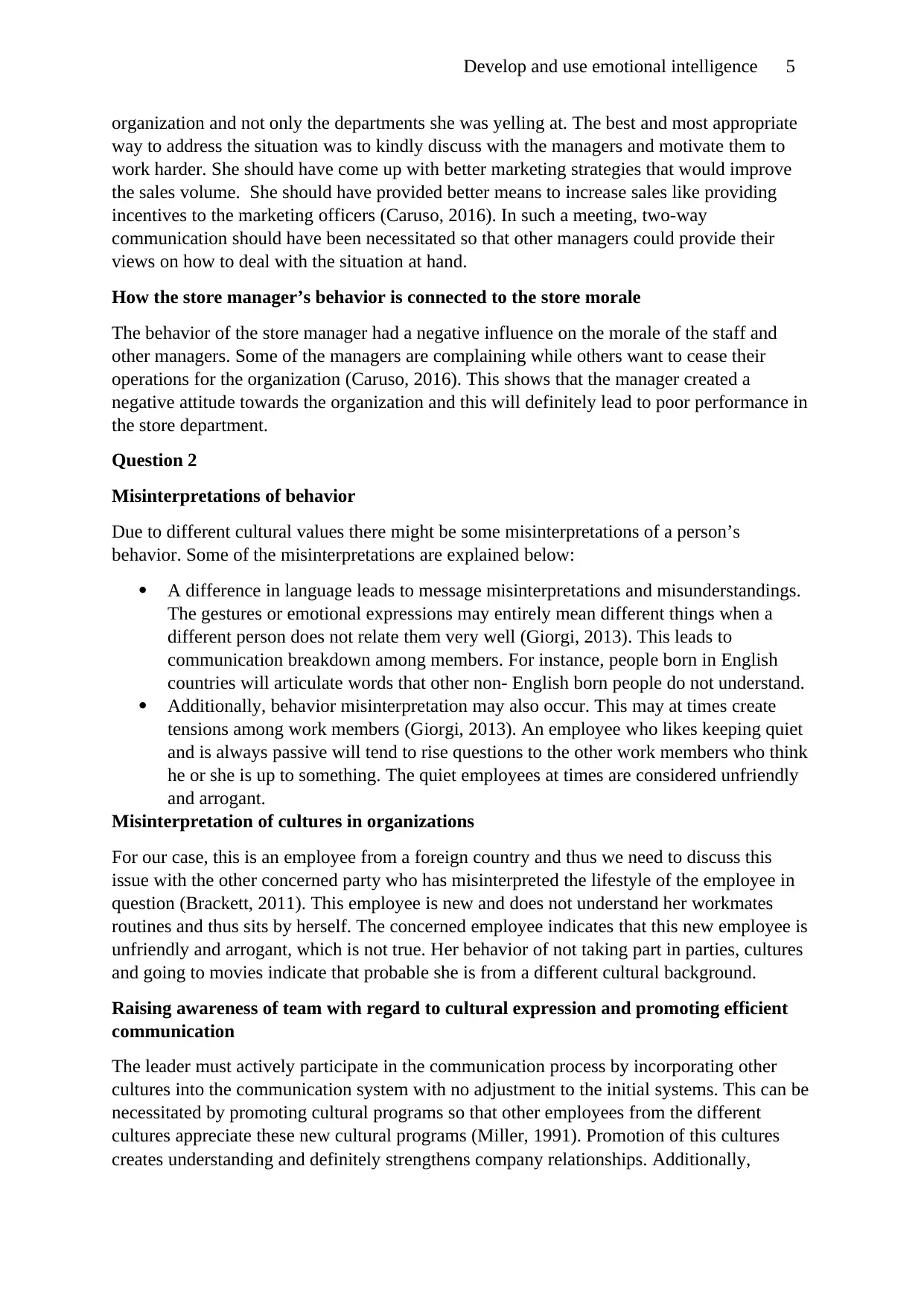
Develop and use emotional intelligence 5
organization and not only the departments she was yelling at. The best and most appropriate
way to address the situation was to kindly discuss with the managers and motivate them to
work harder. She should have come up with better marketing strategies that would improve
the sales volume. She should have provided better means to increase sales like providing
incentives to the marketing officers (Caruso, 2016). In such a meeting, two-way
communication should have been necessitated so that other managers could provide their
views on how to deal with the situation at hand.
How the store manager’s behavior is connected to the store morale
The behavior of the store manager had a negative influence on the morale of the staff and
other managers. Some of the managers are complaining while others want to cease their
operations for the organization (Caruso, 2016). This shows that the manager created a
negative attitude towards the organization and this will definitely lead to poor performance in
the store department.
Question 2
Misinterpretations of behavior
Due to different cultural values there might be some misinterpretations of a person’s
behavior. Some of the misinterpretations are explained below:
A difference in language leads to message misinterpretations and misunderstandings.
The gestures or emotional expressions may entirely mean different things when a
different person does not relate them very well (Giorgi, 2013). This leads to
communication breakdown among members. For instance, people born in English
countries will articulate words that other non- English born people do not understand.
Additionally, behavior misinterpretation may also occur. This may at times create
tensions among work members (Giorgi, 2013). An employee who likes keeping quiet
and is always passive will tend to rise questions to the other work members who think
he or she is up to something. The quiet employees at times are considered unfriendly
and arrogant.
Misinterpretation of cultures in organizations
For our case, this is an employee from a foreign country and thus we need to discuss this
issue with the other concerned party who has misinterpreted the lifestyle of the employee in
question (Brackett, 2011). This employee is new and does not understand her workmates
routines and thus sits by herself. The concerned employee indicates that this new employee is
unfriendly and arrogant, which is not true. Her behavior of not taking part in parties, cultures
and going to movies indicate that probable she is from a different cultural background.
Raising awareness of team with regard to cultural expression and promoting efficient
communication
The leader must actively participate in the communication process by incorporating other
cultures into the communication system with no adjustment to the initial systems. This can be
necessitated by promoting cultural programs so that other employees from the different
cultures appreciate these new cultural programs (Miller, 1991). Promotion of this cultures
creates understanding and definitely strengthens company relationships. Additionally,
organization and not only the departments she was yelling at. The best and most appropriate
way to address the situation was to kindly discuss with the managers and motivate them to
work harder. She should have come up with better marketing strategies that would improve
the sales volume. She should have provided better means to increase sales like providing
incentives to the marketing officers (Caruso, 2016). In such a meeting, two-way
communication should have been necessitated so that other managers could provide their
views on how to deal with the situation at hand.
How the store manager’s behavior is connected to the store morale
The behavior of the store manager had a negative influence on the morale of the staff and
other managers. Some of the managers are complaining while others want to cease their
operations for the organization (Caruso, 2016). This shows that the manager created a
negative attitude towards the organization and this will definitely lead to poor performance in
the store department.
Question 2
Misinterpretations of behavior
Due to different cultural values there might be some misinterpretations of a person’s
behavior. Some of the misinterpretations are explained below:
A difference in language leads to message misinterpretations and misunderstandings.
The gestures or emotional expressions may entirely mean different things when a
different person does not relate them very well (Giorgi, 2013). This leads to
communication breakdown among members. For instance, people born in English
countries will articulate words that other non- English born people do not understand.
Additionally, behavior misinterpretation may also occur. This may at times create
tensions among work members (Giorgi, 2013). An employee who likes keeping quiet
and is always passive will tend to rise questions to the other work members who think
he or she is up to something. The quiet employees at times are considered unfriendly
and arrogant.
Misinterpretation of cultures in organizations
For our case, this is an employee from a foreign country and thus we need to discuss this
issue with the other concerned party who has misinterpreted the lifestyle of the employee in
question (Brackett, 2011). This employee is new and does not understand her workmates
routines and thus sits by herself. The concerned employee indicates that this new employee is
unfriendly and arrogant, which is not true. Her behavior of not taking part in parties, cultures
and going to movies indicate that probable she is from a different cultural background.
Raising awareness of team with regard to cultural expression and promoting efficient
communication
The leader must actively participate in the communication process by incorporating other
cultures into the communication system with no adjustment to the initial systems. This can be
necessitated by promoting cultural programs so that other employees from the different
cultures appreciate these new cultural programs (Miller, 1991). Promotion of this cultures
creates understanding and definitely strengthens company relationships. Additionally,
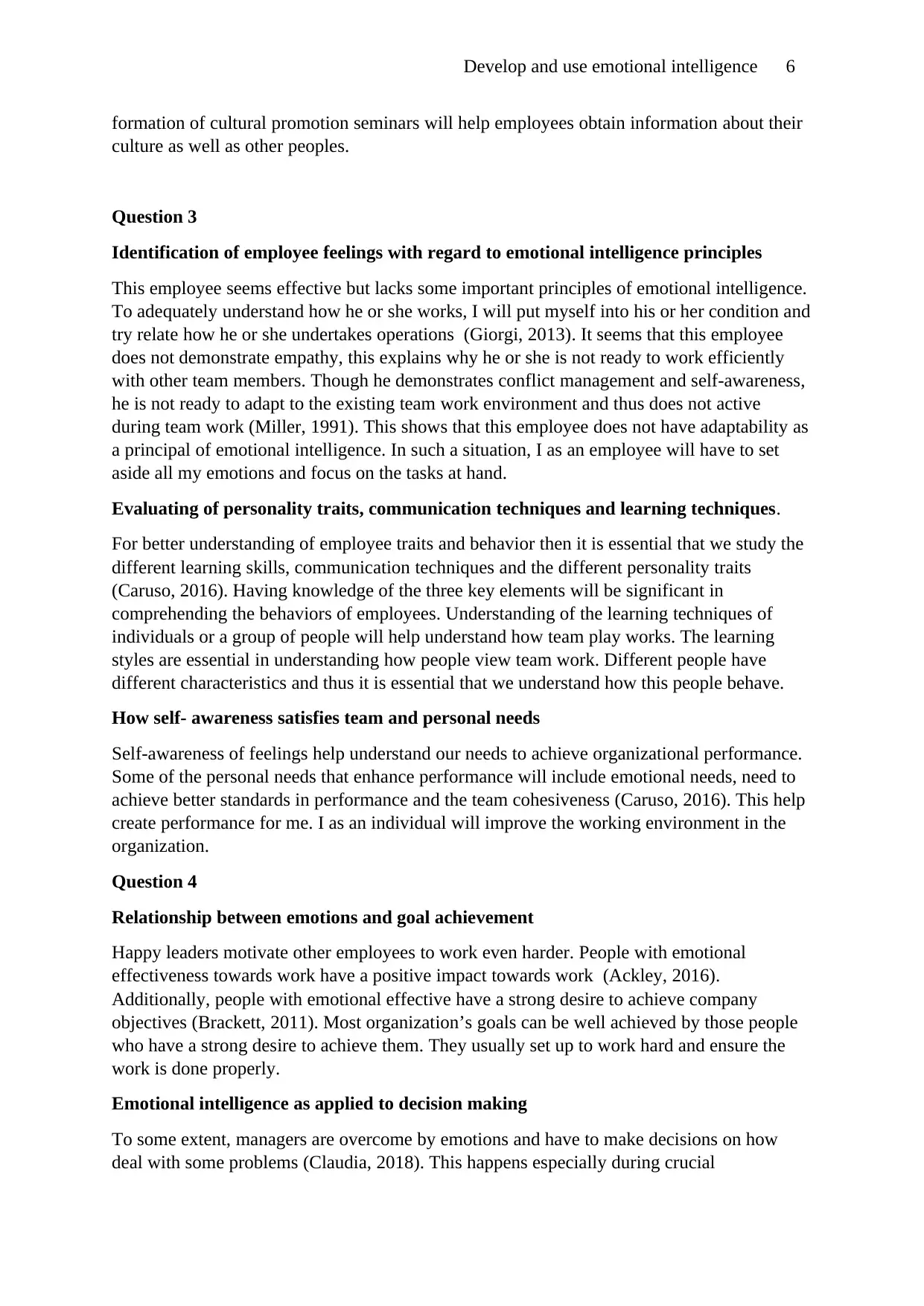
Develop and use emotional intelligence 6
formation of cultural promotion seminars will help employees obtain information about their
culture as well as other peoples.
Question 3
Identification of employee feelings with regard to emotional intelligence principles
This employee seems effective but lacks some important principles of emotional intelligence.
To adequately understand how he or she works, I will put myself into his or her condition and
try relate how he or she undertakes operations (Giorgi, 2013). It seems that this employee
does not demonstrate empathy, this explains why he or she is not ready to work efficiently
with other team members. Though he demonstrates conflict management and self-awareness,
he is not ready to adapt to the existing team work environment and thus does not active
during team work (Miller, 1991). This shows that this employee does not have adaptability as
a principal of emotional intelligence. In such a situation, I as an employee will have to set
aside all my emotions and focus on the tasks at hand.
Evaluating of personality traits, communication techniques and learning techniques.
For better understanding of employee traits and behavior then it is essential that we study the
different learning skills, communication techniques and the different personality traits
(Caruso, 2016). Having knowledge of the three key elements will be significant in
comprehending the behaviors of employees. Understanding of the learning techniques of
individuals or a group of people will help understand how team play works. The learning
styles are essential in understanding how people view team work. Different people have
different characteristics and thus it is essential that we understand how this people behave.
How self- awareness satisfies team and personal needs
Self-awareness of feelings help understand our needs to achieve organizational performance.
Some of the personal needs that enhance performance will include emotional needs, need to
achieve better standards in performance and the team cohesiveness (Caruso, 2016). This help
create performance for me. I as an individual will improve the working environment in the
organization.
Question 4
Relationship between emotions and goal achievement
Happy leaders motivate other employees to work even harder. People with emotional
effectiveness towards work have a positive impact towards work (Ackley, 2016).
Additionally, people with emotional effective have a strong desire to achieve company
objectives (Brackett, 2011). Most organization’s goals can be well achieved by those people
who have a strong desire to achieve them. They usually set up to work hard and ensure the
work is done properly.
Emotional intelligence as applied to decision making
To some extent, managers are overcome by emotions and have to make decisions on how
deal with some problems (Claudia, 2018). This happens especially during crucial
formation of cultural promotion seminars will help employees obtain information about their
culture as well as other peoples.
Question 3
Identification of employee feelings with regard to emotional intelligence principles
This employee seems effective but lacks some important principles of emotional intelligence.
To adequately understand how he or she works, I will put myself into his or her condition and
try relate how he or she undertakes operations (Giorgi, 2013). It seems that this employee
does not demonstrate empathy, this explains why he or she is not ready to work efficiently
with other team members. Though he demonstrates conflict management and self-awareness,
he is not ready to adapt to the existing team work environment and thus does not active
during team work (Miller, 1991). This shows that this employee does not have adaptability as
a principal of emotional intelligence. In such a situation, I as an employee will have to set
aside all my emotions and focus on the tasks at hand.
Evaluating of personality traits, communication techniques and learning techniques.
For better understanding of employee traits and behavior then it is essential that we study the
different learning skills, communication techniques and the different personality traits
(Caruso, 2016). Having knowledge of the three key elements will be significant in
comprehending the behaviors of employees. Understanding of the learning techniques of
individuals or a group of people will help understand how team play works. The learning
styles are essential in understanding how people view team work. Different people have
different characteristics and thus it is essential that we understand how this people behave.
How self- awareness satisfies team and personal needs
Self-awareness of feelings help understand our needs to achieve organizational performance.
Some of the personal needs that enhance performance will include emotional needs, need to
achieve better standards in performance and the team cohesiveness (Caruso, 2016). This help
create performance for me. I as an individual will improve the working environment in the
organization.
Question 4
Relationship between emotions and goal achievement
Happy leaders motivate other employees to work even harder. People with emotional
effectiveness towards work have a positive impact towards work (Ackley, 2016).
Additionally, people with emotional effective have a strong desire to achieve company
objectives (Brackett, 2011). Most organization’s goals can be well achieved by those people
who have a strong desire to achieve them. They usually set up to work hard and ensure the
work is done properly.
Emotional intelligence as applied to decision making
To some extent, managers are overcome by emotions and have to make decisions on how
deal with some problems (Claudia, 2018). This happens especially during crucial

Develop and use emotional intelligence 7
circumstances. The process of integrating emotions in making decisions will be more rational
and always decisions made lead to better performances. In our case, to ensure effective and
efficient operations then it is essential that we corporate this two efficiently.
Decision making process
The following are the stages in the process of decision making:
1. Identification of the need or problems.
This will involve identify and selecting the needs or the complex situations in an organization
(Brackett, 2011). Here the problem is identifying the performance goals.
2. Generation of alternative needs.
In any organization, not only one problem is experienced but several problems occur.
Generating other decisions will be very vital in improving performance.
3. Evaluating the positive and negative impacts of the decisions.
Here we try to evaluate the consequences of the decisions chosen (Feldman, 2005). We look
at how both will influence an organization.
4. Selection of the best decision.
This is the final stage in decision making where the best solution is selected from the ones
above. For our case, the best and most viable solution will be to develop performance targets.
Policies, rules and regulations in decision making
In any organization, ethics is a vital tool that must be addressed. Organizations must ensure
that government rules and regulations are followed adequately (Feldman, 2005). All the
policies must be followed by both the management and the employees. To satisfy the internal
requirements in an organization then employees must follow the rules, regulations and
policies set by the different departments (Grant, 2012). To satisfy the external environment
then the rules, regulations and policies outside the organization must be followed. For
example, government policies such as quotas and others must be followed.
Importance of WHS legislations in decision implementation.
In decision implementation, the management is required to consider the operations health
service and the working health safety to ensure that employees are protected from any
damage (Grant, 2012). The OHS and WHS will help in making guidelines on how standards
in the organization should be. These will prevent damages to the employees and also ensure
efficient and environmental friendly organization.
Assessment 3
Appendix 1: Role-play scenario
Appendix one: Role play scenario.
Start the session with a positive open mind by highlighting why coaching is important in this
case. Ask for Pat’s Input.
Pat should then describe her personal issues, performance, challenges to better performance,
inner feelings towards the task assigned to her and the ability to achieve job satisfaction.
circumstances. The process of integrating emotions in making decisions will be more rational
and always decisions made lead to better performances. In our case, to ensure effective and
efficient operations then it is essential that we corporate this two efficiently.
Decision making process
The following are the stages in the process of decision making:
1. Identification of the need or problems.
This will involve identify and selecting the needs or the complex situations in an organization
(Brackett, 2011). Here the problem is identifying the performance goals.
2. Generation of alternative needs.
In any organization, not only one problem is experienced but several problems occur.
Generating other decisions will be very vital in improving performance.
3. Evaluating the positive and negative impacts of the decisions.
Here we try to evaluate the consequences of the decisions chosen (Feldman, 2005). We look
at how both will influence an organization.
4. Selection of the best decision.
This is the final stage in decision making where the best solution is selected from the ones
above. For our case, the best and most viable solution will be to develop performance targets.
Policies, rules and regulations in decision making
In any organization, ethics is a vital tool that must be addressed. Organizations must ensure
that government rules and regulations are followed adequately (Feldman, 2005). All the
policies must be followed by both the management and the employees. To satisfy the internal
requirements in an organization then employees must follow the rules, regulations and
policies set by the different departments (Grant, 2012). To satisfy the external environment
then the rules, regulations and policies outside the organization must be followed. For
example, government policies such as quotas and others must be followed.
Importance of WHS legislations in decision implementation.
In decision implementation, the management is required to consider the operations health
service and the working health safety to ensure that employees are protected from any
damage (Grant, 2012). The OHS and WHS will help in making guidelines on how standards
in the organization should be. These will prevent damages to the employees and also ensure
efficient and environmental friendly organization.
Assessment 3
Appendix 1: Role-play scenario
Appendix one: Role play scenario.
Start the session with a positive open mind by highlighting why coaching is important in this
case. Ask for Pat’s Input.
Pat should then describe her personal issues, performance, challenges to better performance,
inner feelings towards the task assigned to her and the ability to achieve job satisfaction.
Paraphrase This Document
Need a fresh take? Get an instant paraphrase of this document with our AI Paraphraser
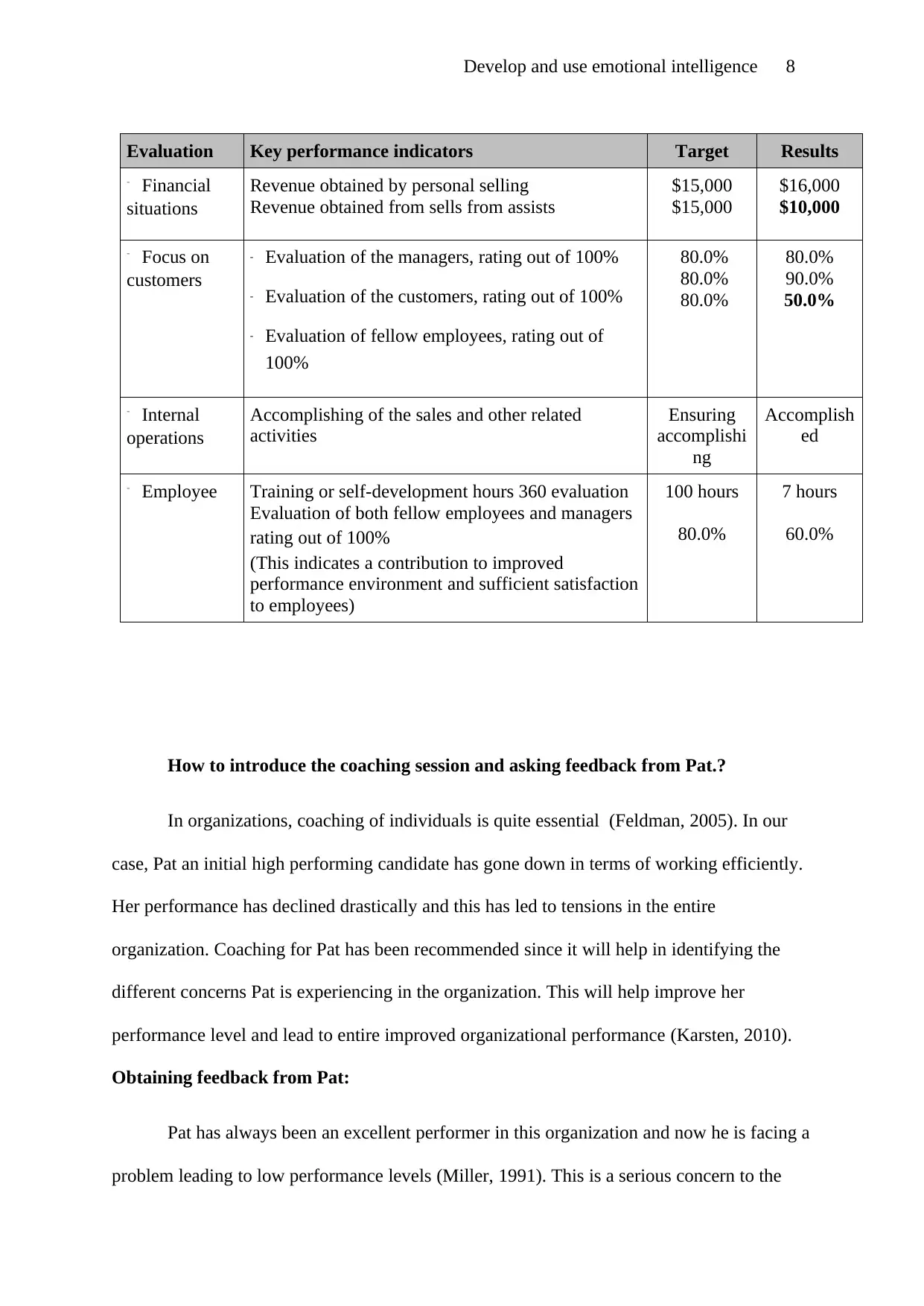
Develop and use emotional intelligence 8
Evaluation Key performance indicators Target Results
- Financial
situations
Revenue obtained by personal selling
Revenue obtained from sells from assists
$15,000
$15,000
$16,000
$10,000
- Focus on
customers
- Evaluation of the managers, rating out of 100%
- Evaluation of the customers, rating out of 100%
- Evaluation of fellow employees, rating out of
100%
80.0%
80.0%
80.0%
80.0%
90.0%
50.0%
- Internal
operations
Accomplishing of the sales and other related
activities
Ensuring
accomplishi
ng
Accomplish
ed
- Employee Training or self-development hours 360 evaluation
Evaluation of both fellow employees and managers
rating out of 100%
(This indicates a contribution to improved
performance environment and sufficient satisfaction
to employees)
100 hours
80.0%
7 hours
60.0%
How to introduce the coaching session and asking feedback from Pat.?
In organizations, coaching of individuals is quite essential (Feldman, 2005). In our
case, Pat an initial high performing candidate has gone down in terms of working efficiently.
Her performance has declined drastically and this has led to tensions in the entire
organization. Coaching for Pat has been recommended since it will help in identifying the
different concerns Pat is experiencing in the organization. This will help improve her
performance level and lead to entire improved organizational performance (Karsten, 2010).
Obtaining feedback from Pat:
Pat has always been an excellent performer in this organization and now he is facing a
problem leading to low performance levels (Miller, 1991). This is a serious concern to the
Evaluation Key performance indicators Target Results
- Financial
situations
Revenue obtained by personal selling
Revenue obtained from sells from assists
$15,000
$15,000
$16,000
$10,000
- Focus on
customers
- Evaluation of the managers, rating out of 100%
- Evaluation of the customers, rating out of 100%
- Evaluation of fellow employees, rating out of
100%
80.0%
80.0%
80.0%
80.0%
90.0%
50.0%
- Internal
operations
Accomplishing of the sales and other related
activities
Ensuring
accomplishi
ng
Accomplish
ed
- Employee Training or self-development hours 360 evaluation
Evaluation of both fellow employees and managers
rating out of 100%
(This indicates a contribution to improved
performance environment and sufficient satisfaction
to employees)
100 hours
80.0%
7 hours
60.0%
How to introduce the coaching session and asking feedback from Pat.?
In organizations, coaching of individuals is quite essential (Feldman, 2005). In our
case, Pat an initial high performing candidate has gone down in terms of working efficiently.
Her performance has declined drastically and this has led to tensions in the entire
organization. Coaching for Pat has been recommended since it will help in identifying the
different concerns Pat is experiencing in the organization. This will help improve her
performance level and lead to entire improved organizational performance (Karsten, 2010).
Obtaining feedback from Pat:
Pat has always been an excellent performer in this organization and now he is facing a
problem leading to low performance levels (Miller, 1991). This is a serious concern to the
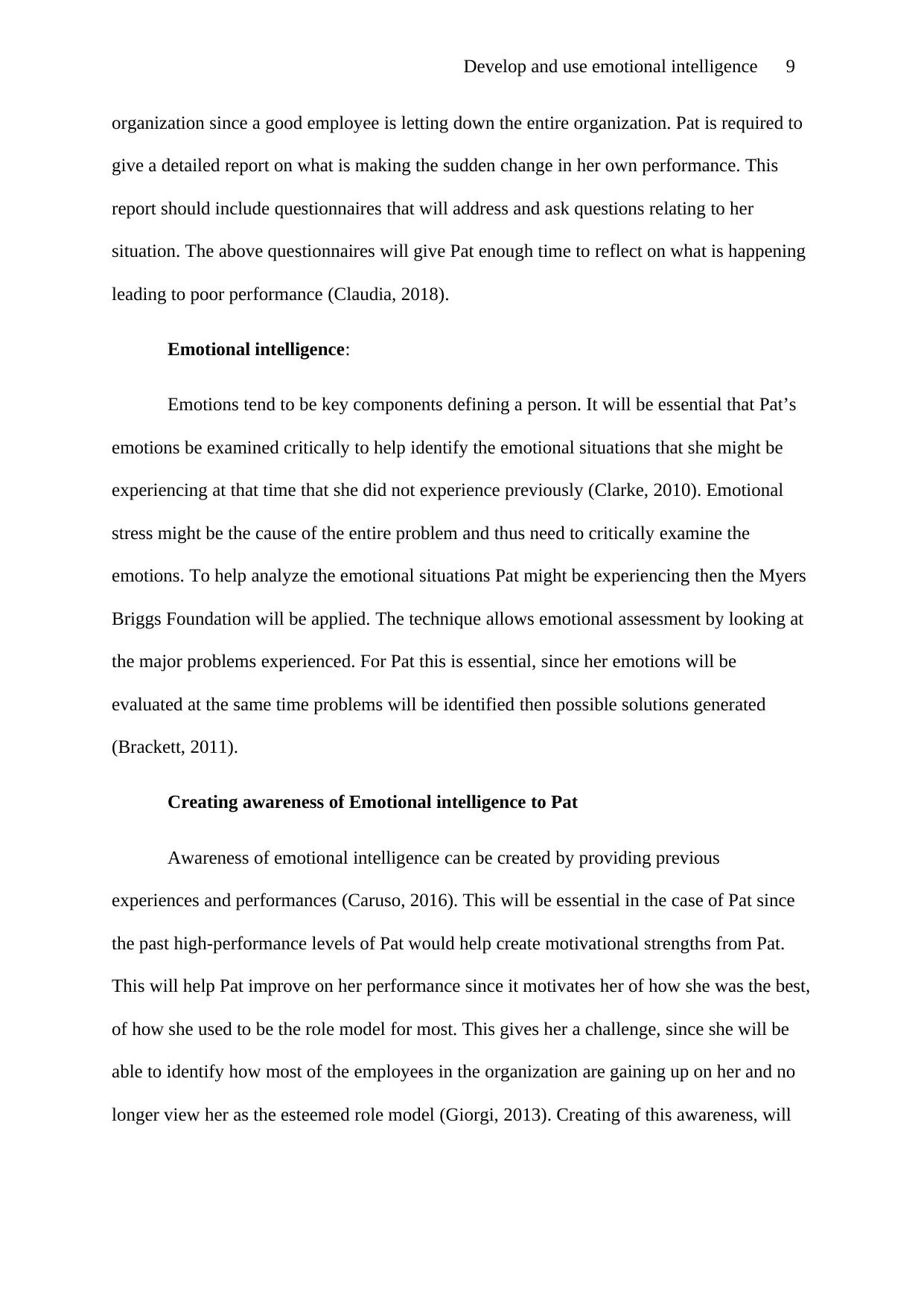
Develop and use emotional intelligence 9
organization since a good employee is letting down the entire organization. Pat is required to
give a detailed report on what is making the sudden change in her own performance. This
report should include questionnaires that will address and ask questions relating to her
situation. The above questionnaires will give Pat enough time to reflect on what is happening
leading to poor performance (Claudia, 2018).
Emotional intelligence:
Emotions tend to be key components defining a person. It will be essential that Pat’s
emotions be examined critically to help identify the emotional situations that she might be
experiencing at that time that she did not experience previously (Clarke, 2010). Emotional
stress might be the cause of the entire problem and thus need to critically examine the
emotions. To help analyze the emotional situations Pat might be experiencing then the Myers
Briggs Foundation will be applied. The technique allows emotional assessment by looking at
the major problems experienced. For Pat this is essential, since her emotions will be
evaluated at the same time problems will be identified then possible solutions generated
(Brackett, 2011).
Creating awareness of Emotional intelligence to Pat
Awareness of emotional intelligence can be created by providing previous
experiences and performances (Caruso, 2016). This will be essential in the case of Pat since
the past high-performance levels of Pat would help create motivational strengths from Pat.
This will help Pat improve on her performance since it motivates her of how she was the best,
of how she used to be the role model for most. This gives her a challenge, since she will be
able to identify how most of the employees in the organization are gaining up on her and no
longer view her as the esteemed role model (Giorgi, 2013). Creating of this awareness, will
organization since a good employee is letting down the entire organization. Pat is required to
give a detailed report on what is making the sudden change in her own performance. This
report should include questionnaires that will address and ask questions relating to her
situation. The above questionnaires will give Pat enough time to reflect on what is happening
leading to poor performance (Claudia, 2018).
Emotional intelligence:
Emotions tend to be key components defining a person. It will be essential that Pat’s
emotions be examined critically to help identify the emotional situations that she might be
experiencing at that time that she did not experience previously (Clarke, 2010). Emotional
stress might be the cause of the entire problem and thus need to critically examine the
emotions. To help analyze the emotional situations Pat might be experiencing then the Myers
Briggs Foundation will be applied. The technique allows emotional assessment by looking at
the major problems experienced. For Pat this is essential, since her emotions will be
evaluated at the same time problems will be identified then possible solutions generated
(Brackett, 2011).
Creating awareness of Emotional intelligence to Pat
Awareness of emotional intelligence can be created by providing previous
experiences and performances (Caruso, 2016). This will be essential in the case of Pat since
the past high-performance levels of Pat would help create motivational strengths from Pat.
This will help Pat improve on her performance since it motivates her of how she was the best,
of how she used to be the role model for most. This gives her a challenge, since she will be
able to identify how most of the employees in the organization are gaining up on her and no
longer view her as the esteemed role model (Giorgi, 2013). Creating of this awareness, will
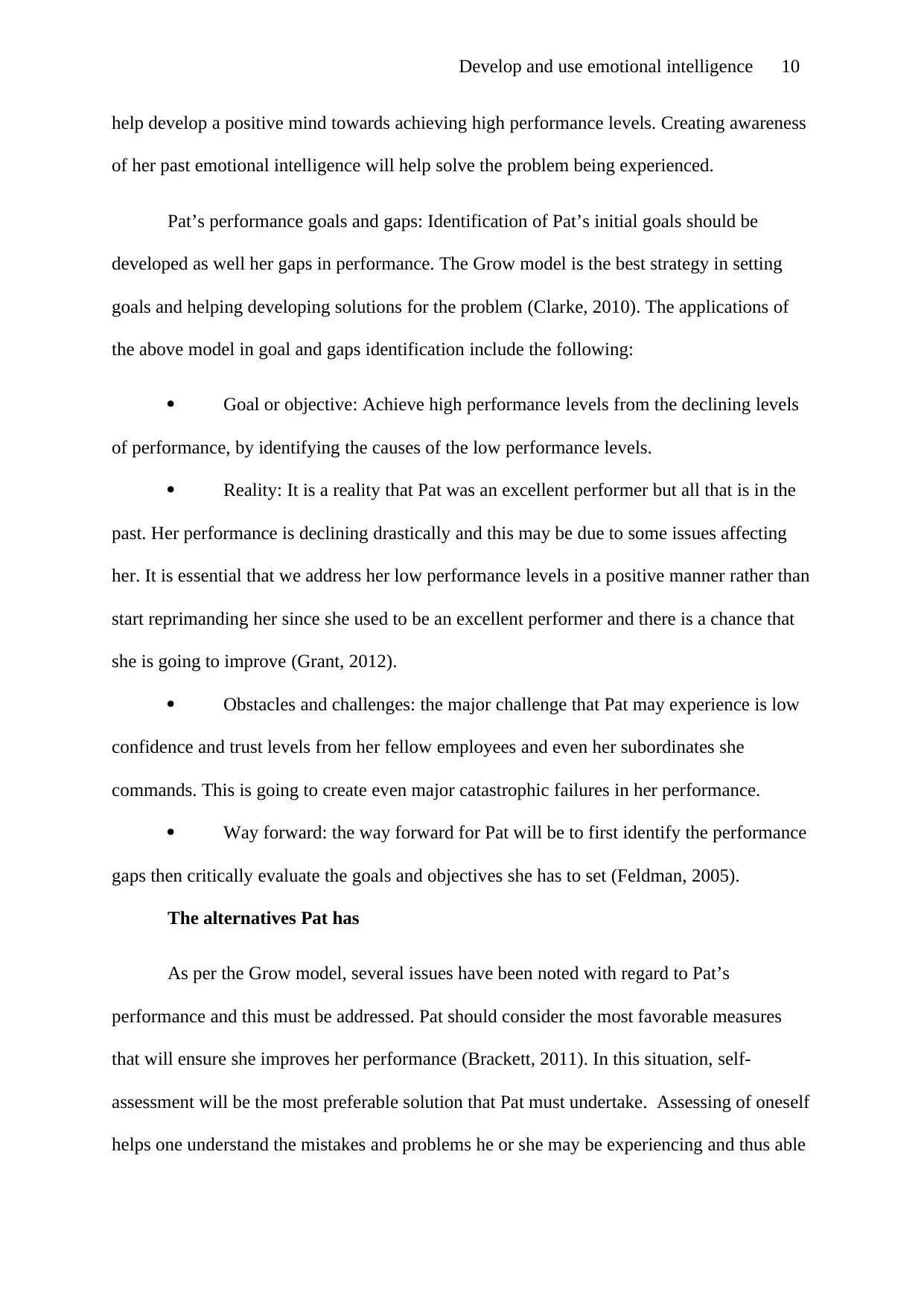
Develop and use emotional intelligence 10
help develop a positive mind towards achieving high performance levels. Creating awareness
of her past emotional intelligence will help solve the problem being experienced.
Pat’s performance goals and gaps: Identification of Pat’s initial goals should be
developed as well her gaps in performance. The Grow model is the best strategy in setting
goals and helping developing solutions for the problem (Clarke, 2010). The applications of
the above model in goal and gaps identification include the following:
Goal or objective: Achieve high performance levels from the declining levels
of performance, by identifying the causes of the low performance levels.
Reality: It is a reality that Pat was an excellent performer but all that is in the
past. Her performance is declining drastically and this may be due to some issues affecting
her. It is essential that we address her low performance levels in a positive manner rather than
start reprimanding her since she used to be an excellent performer and there is a chance that
she is going to improve (Grant, 2012).
Obstacles and challenges: the major challenge that Pat may experience is low
confidence and trust levels from her fellow employees and even her subordinates she
commands. This is going to create even major catastrophic failures in her performance.
Way forward: the way forward for Pat will be to first identify the performance
gaps then critically evaluate the goals and objectives she has to set (Feldman, 2005).
The alternatives Pat has
As per the Grow model, several issues have been noted with regard to Pat’s
performance and this must be addressed. Pat should consider the most favorable measures
that will ensure she improves her performance (Brackett, 2011). In this situation, self-
assessment will be the most preferable solution that Pat must undertake. Assessing of oneself
helps one understand the mistakes and problems he or she may be experiencing and thus able
help develop a positive mind towards achieving high performance levels. Creating awareness
of her past emotional intelligence will help solve the problem being experienced.
Pat’s performance goals and gaps: Identification of Pat’s initial goals should be
developed as well her gaps in performance. The Grow model is the best strategy in setting
goals and helping developing solutions for the problem (Clarke, 2010). The applications of
the above model in goal and gaps identification include the following:
Goal or objective: Achieve high performance levels from the declining levels
of performance, by identifying the causes of the low performance levels.
Reality: It is a reality that Pat was an excellent performer but all that is in the
past. Her performance is declining drastically and this may be due to some issues affecting
her. It is essential that we address her low performance levels in a positive manner rather than
start reprimanding her since she used to be an excellent performer and there is a chance that
she is going to improve (Grant, 2012).
Obstacles and challenges: the major challenge that Pat may experience is low
confidence and trust levels from her fellow employees and even her subordinates she
commands. This is going to create even major catastrophic failures in her performance.
Way forward: the way forward for Pat will be to first identify the performance
gaps then critically evaluate the goals and objectives she has to set (Feldman, 2005).
The alternatives Pat has
As per the Grow model, several issues have been noted with regard to Pat’s
performance and this must be addressed. Pat should consider the most favorable measures
that will ensure she improves her performance (Brackett, 2011). In this situation, self-
assessment will be the most preferable solution that Pat must undertake. Assessing of oneself
helps one understand the mistakes and problems he or she may be experiencing and thus able
Secure Best Marks with AI Grader
Need help grading? Try our AI Grader for instant feedback on your assignments.
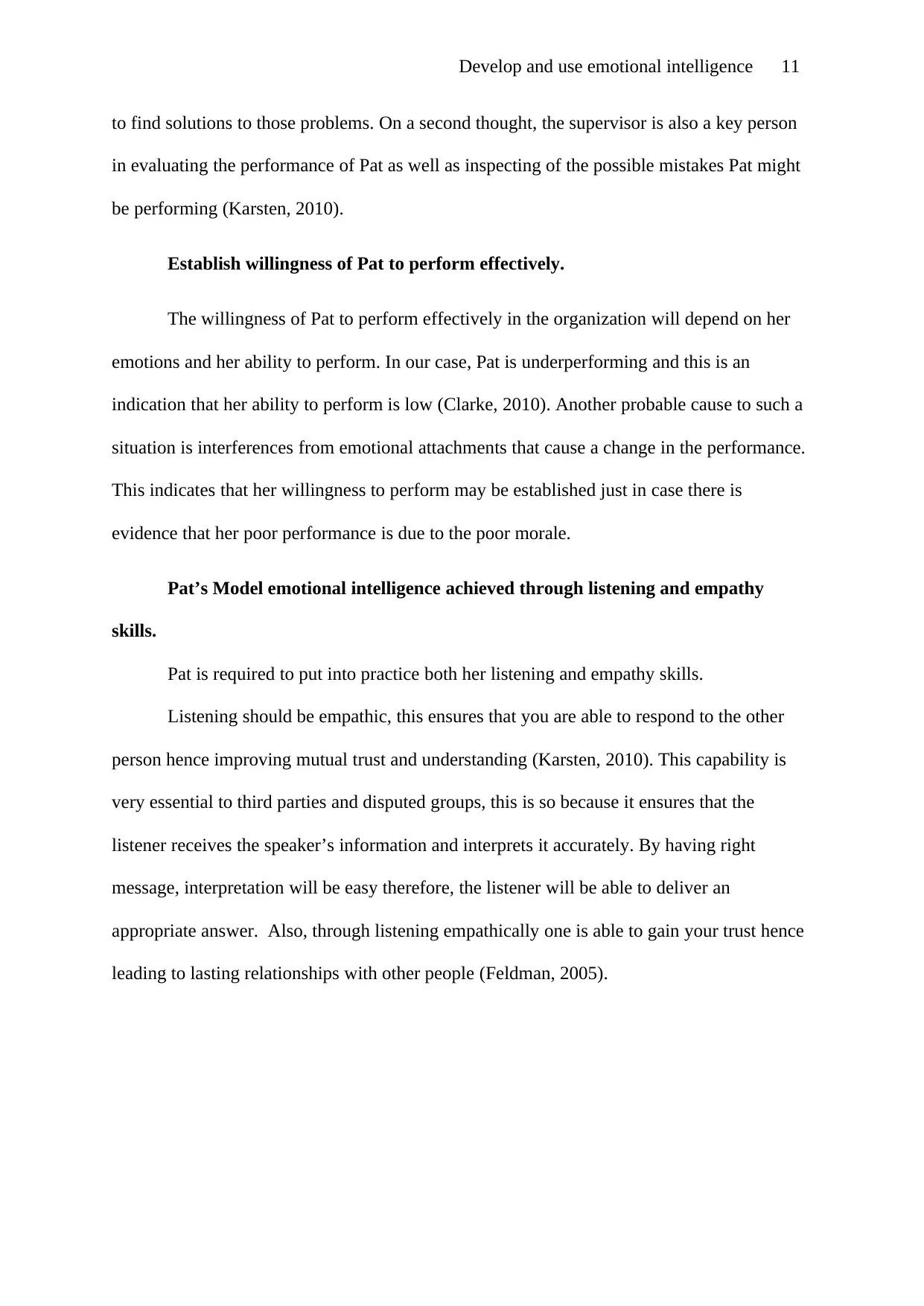
Develop and use emotional intelligence 11
to find solutions to those problems. On a second thought, the supervisor is also a key person
in evaluating the performance of Pat as well as inspecting of the possible mistakes Pat might
be performing (Karsten, 2010).
Establish willingness of Pat to perform effectively.
The willingness of Pat to perform effectively in the organization will depend on her
emotions and her ability to perform. In our case, Pat is underperforming and this is an
indication that her ability to perform is low (Clarke, 2010). Another probable cause to such a
situation is interferences from emotional attachments that cause a change in the performance.
This indicates that her willingness to perform may be established just in case there is
evidence that her poor performance is due to the poor morale.
Pat’s Model emotional intelligence achieved through listening and empathy
skills.
Pat is required to put into practice both her listening and empathy skills.
Listening should be empathic, this ensures that you are able to respond to the other
person hence improving mutual trust and understanding (Karsten, 2010). This capability is
very essential to third parties and disputed groups, this is so because it ensures that the
listener receives the speaker’s information and interprets it accurately. By having right
message, interpretation will be easy therefore, the listener will be able to deliver an
appropriate answer. Also, through listening empathically one is able to gain your trust hence
leading to lasting relationships with other people (Feldman, 2005).
to find solutions to those problems. On a second thought, the supervisor is also a key person
in evaluating the performance of Pat as well as inspecting of the possible mistakes Pat might
be performing (Karsten, 2010).
Establish willingness of Pat to perform effectively.
The willingness of Pat to perform effectively in the organization will depend on her
emotions and her ability to perform. In our case, Pat is underperforming and this is an
indication that her ability to perform is low (Clarke, 2010). Another probable cause to such a
situation is interferences from emotional attachments that cause a change in the performance.
This indicates that her willingness to perform may be established just in case there is
evidence that her poor performance is due to the poor morale.
Pat’s Model emotional intelligence achieved through listening and empathy
skills.
Pat is required to put into practice both her listening and empathy skills.
Listening should be empathic, this ensures that you are able to respond to the other
person hence improving mutual trust and understanding (Karsten, 2010). This capability is
very essential to third parties and disputed groups, this is so because it ensures that the
listener receives the speaker’s information and interprets it accurately. By having right
message, interpretation will be easy therefore, the listener will be able to deliver an
appropriate answer. Also, through listening empathically one is able to gain your trust hence
leading to lasting relationships with other people (Feldman, 2005).

Develop and use emotional intelligence 12
Building Pat’s awareness of emotional intelligence weaknesses and strengths
By use of the GROW model, establish Pat’s performance gaps and goals
(reality):
“What is the process to be followed?” is amongst the most commonly asked question
concerning coaching. Obviously, there are many responses to that particular question
(Ackley, 2016). However, if one assumes that coaching is a widely organized interaction
regarding the subject in that the coach is responsible for asking questions and encouraging the
trainees to establish solutions to their challenges or issues they incur, the automatically
GROW approach is the most widely applied.
Building Pat’s awareness of emotional intelligence weaknesses and strengths
By use of the GROW model, establish Pat’s performance gaps and goals
(reality):
“What is the process to be followed?” is amongst the most commonly asked question
concerning coaching. Obviously, there are many responses to that particular question
(Ackley, 2016). However, if one assumes that coaching is a widely organized interaction
regarding the subject in that the coach is responsible for asking questions and encouraging the
trainees to establish solutions to their challenges or issues they incur, the automatically
GROW approach is the most widely applied.
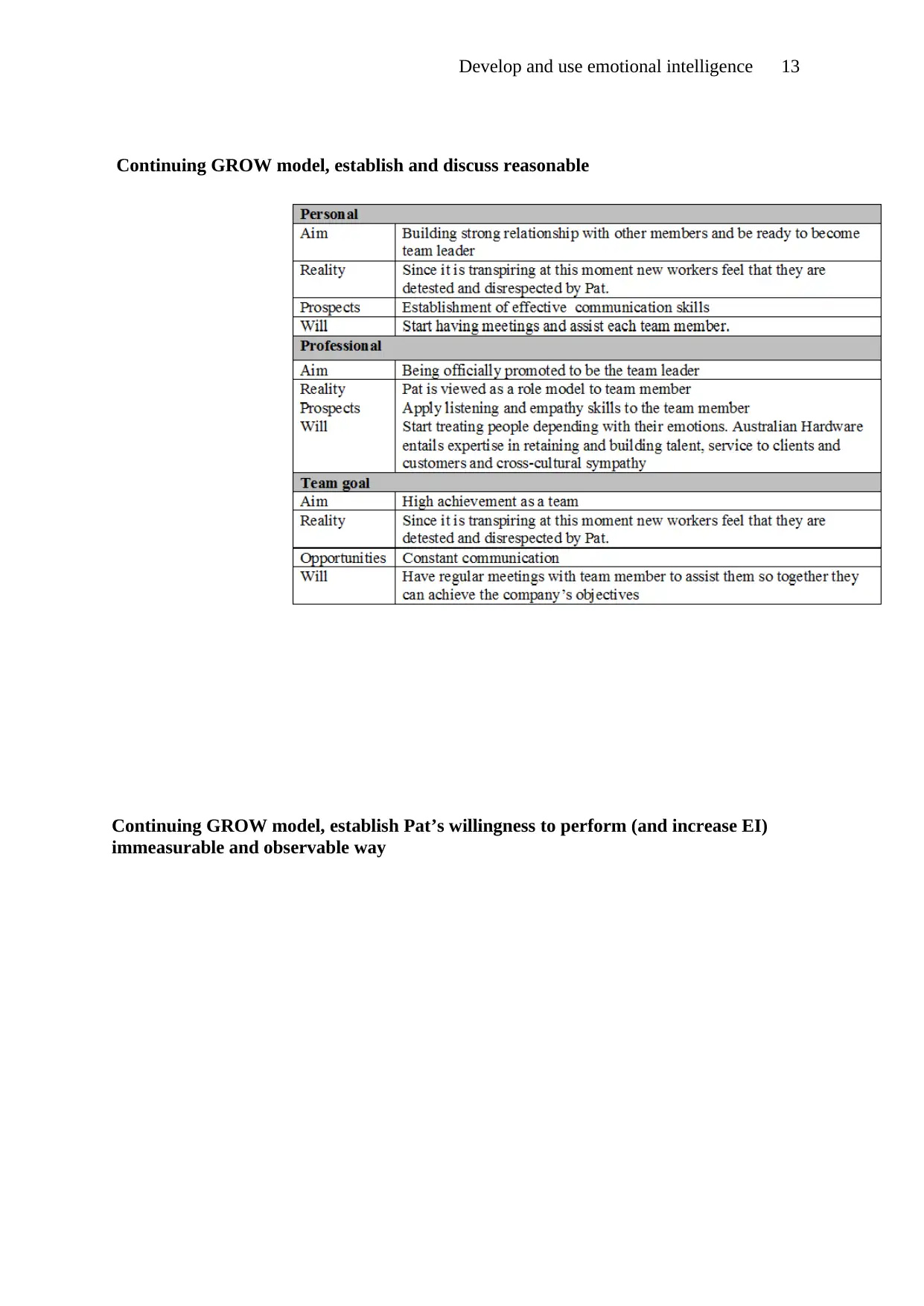
Develop and use emotional intelligence 13
Continuing GROW model, establish and discuss reasonable
Continuing GROW model, establish Pat’s willingness to perform (and increase EI)
immeasurable and observable way
Continuing GROW model, establish and discuss reasonable
Continuing GROW model, establish Pat’s willingness to perform (and increase EI)
immeasurable and observable way
Paraphrase This Document
Need a fresh take? Get an instant paraphrase of this document with our AI Paraphraser
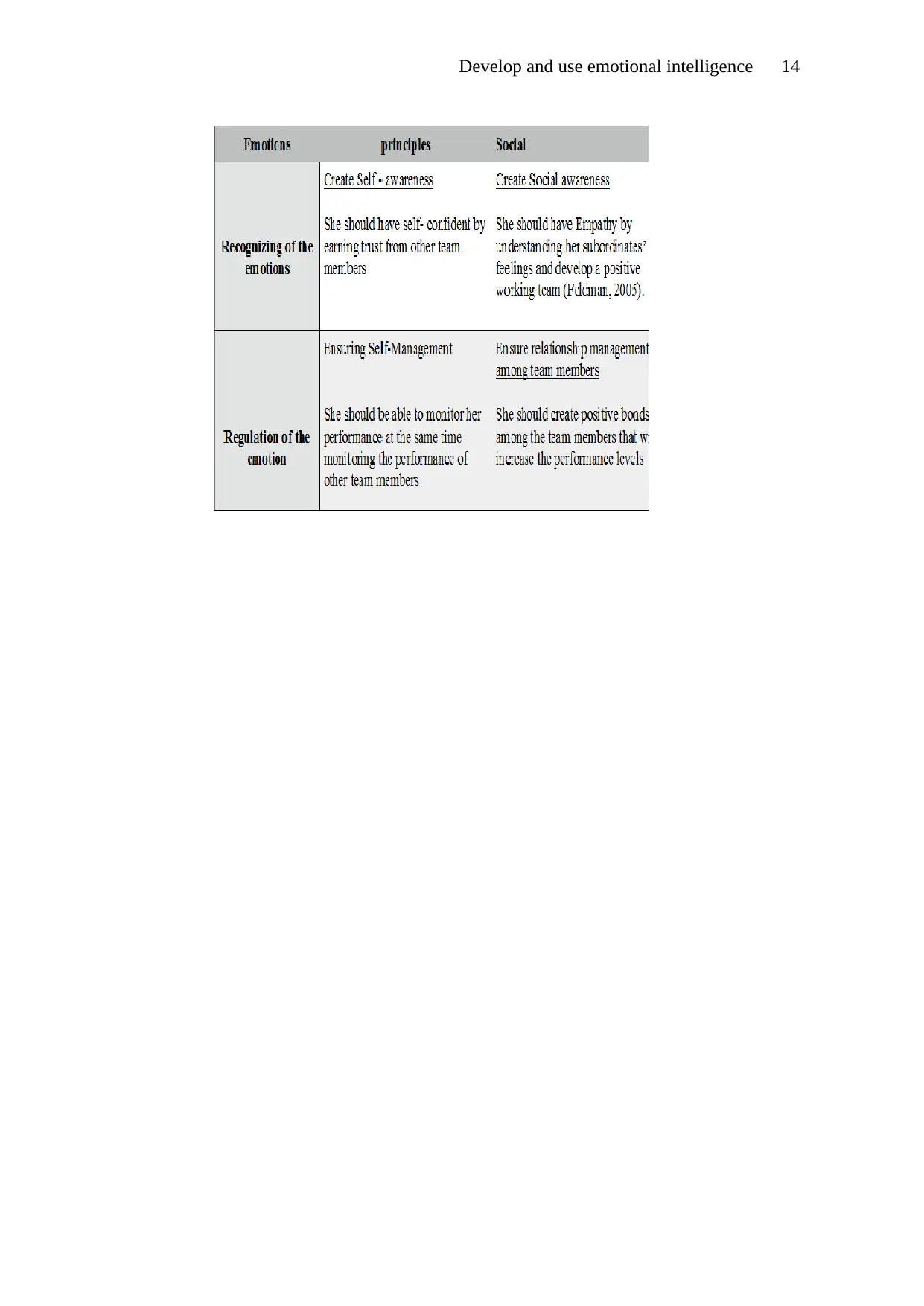
Develop and use emotional intelligence 14
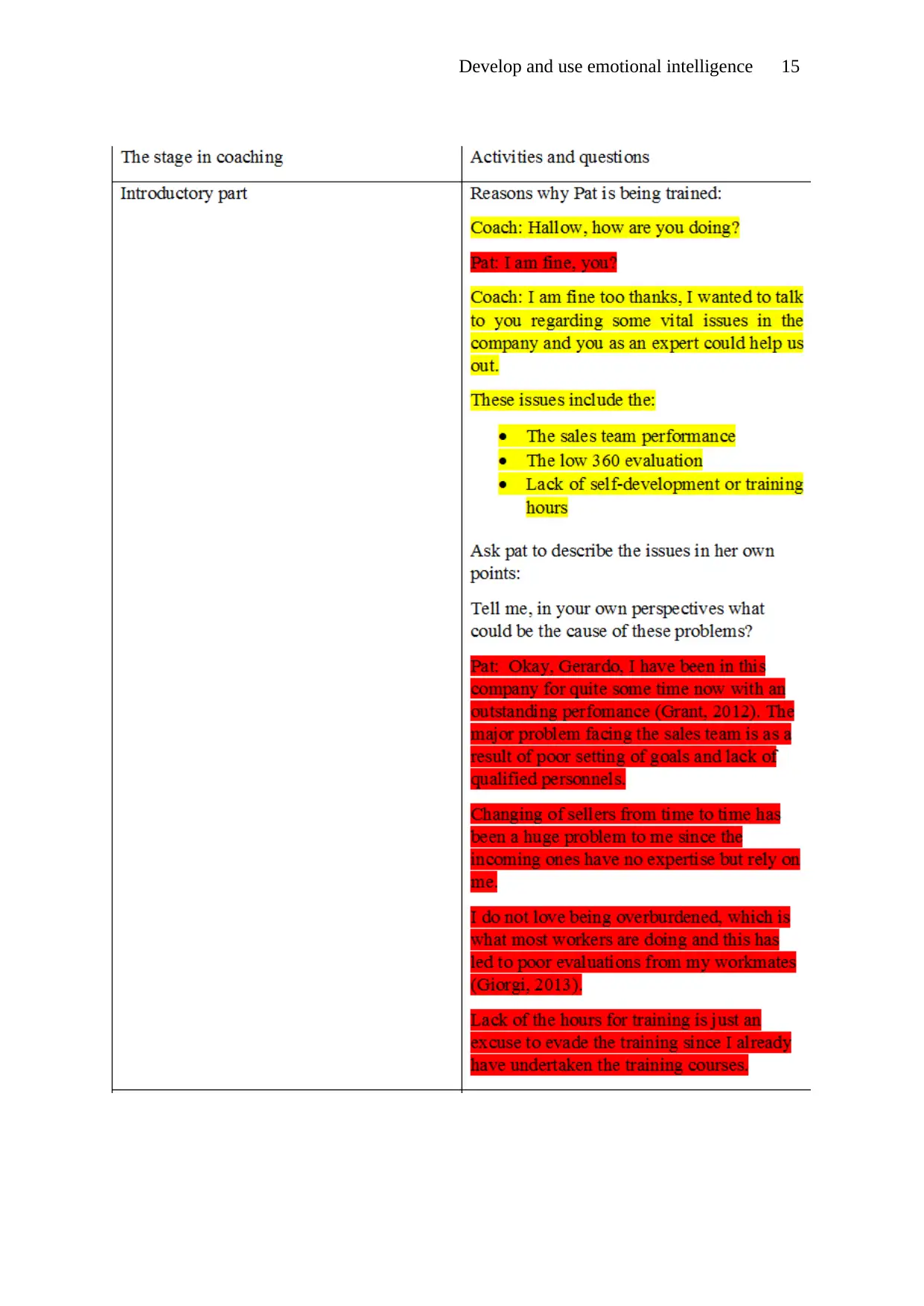
Develop and use emotional intelligence 15
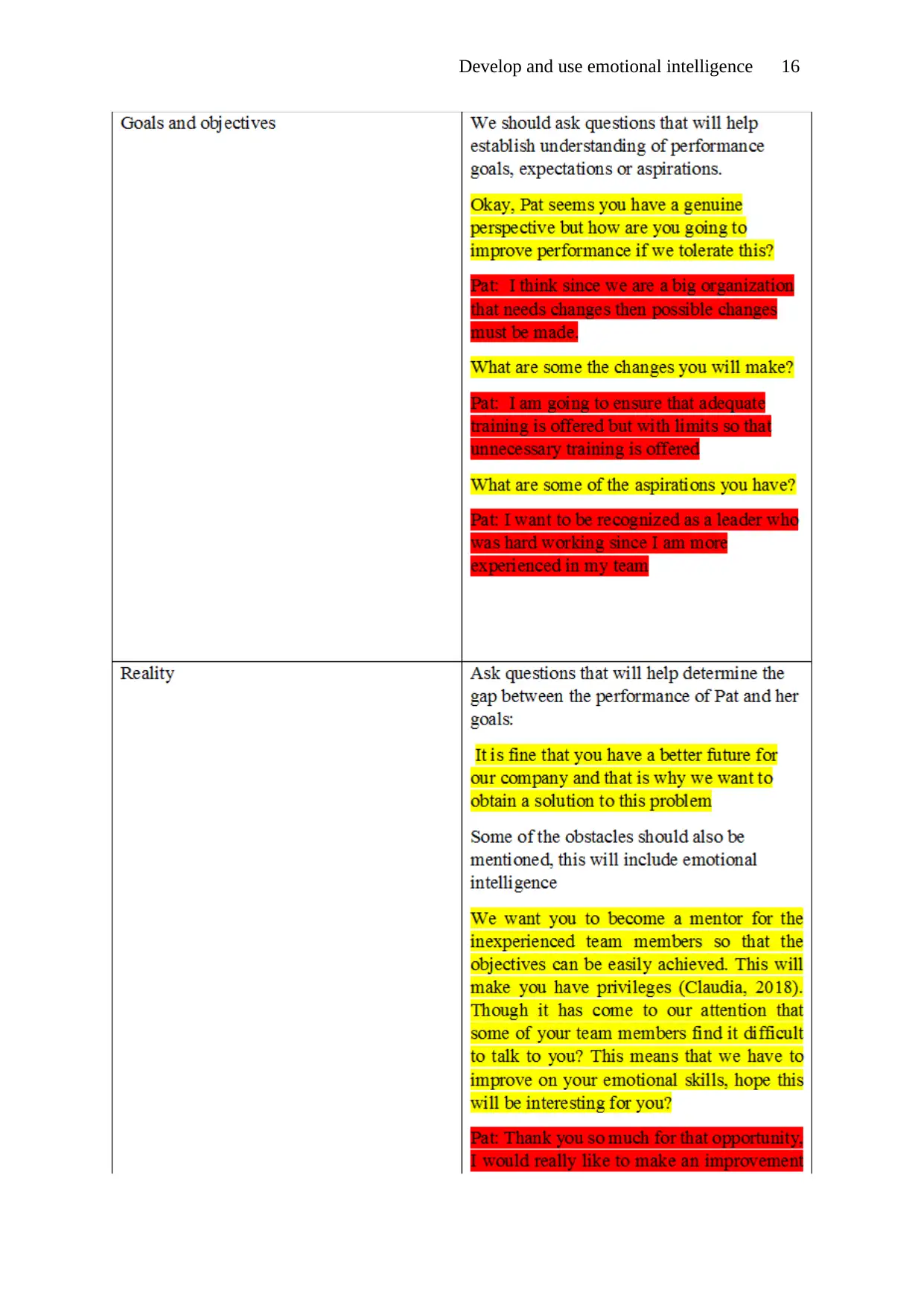
Develop and use emotional intelligence 16
Secure Best Marks with AI Grader
Need help grading? Try our AI Grader for instant feedback on your assignments.
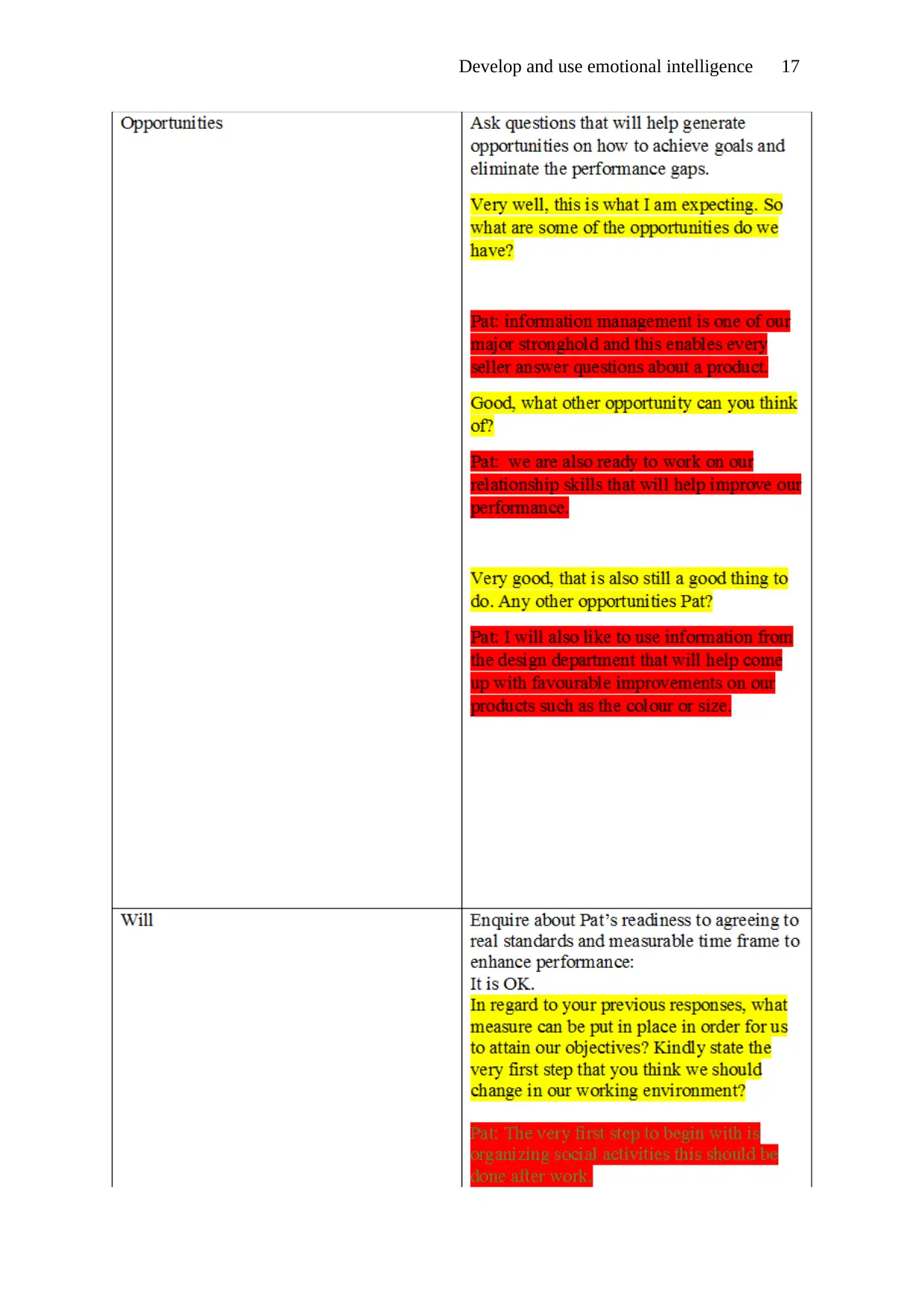
Develop and use emotional intelligence 17

Develop and use emotional intelligence 18
Bibliography
Ackley, D., 2016. Emotional intelligence: A practical review of models, measures, and
applications.. Consulting Psychology Journal, 68(8), pp. 270-282.
Caruso, D. R., 2016. Special Issue on Emotional Intelligence. Business Perspective and
Research, 4(1), pp. 14-22.
Clarke, N., 2010. Emotional intelligence and learning in teams. Journal of Workplace
Learning, 22(3), pp. 127-130.
Claudia, F. &., 2018. Emotional Intelligence in the Workplace. Journal of Public Health
Mnagement and Practice, 24(3), pp. 4-9.
Feldman, D. C., 2005. Executive Coaching: A Review and Agenda for Future Research.
Journal of Management, 31(6), pp. 6-19.
Giorgi, G., 2013. Organizational emotional intelligence: development of a model.
International Journal of Organizational Analysis, 21(1), pp. 5-11.
Grant, A. M., 2012. An integrated model of goal-focused coaching: An evidence-based
framework for teaching and practice. International Coaching Psychology Review, 7(2), pp.
147-149.
Karsten, M., 2010. Professional Coaching as an Effective Strategy to Retaining Frontline
Managers. Journal of Nursing Administration, 40(3), pp. 141-143.
Marc A. Brackett, S. E. R. &. P. S., 2011. Emotional Intelligence: Implications for Personal,
Social, Academic, and Workplace Success, Yale: Yale University.
Susan Peterson Miller, C. H. &. A. W., 1991. A Method for Increasing Effective and
Decreasing Ineffective Teacher Behaviors. Teacher Education and Special Education: The
Journal of Teachers Education Division of the Council for Exceptional Children, 14(3), pp.
15-20.
Bibliography
Ackley, D., 2016. Emotional intelligence: A practical review of models, measures, and
applications.. Consulting Psychology Journal, 68(8), pp. 270-282.
Caruso, D. R., 2016. Special Issue on Emotional Intelligence. Business Perspective and
Research, 4(1), pp. 14-22.
Clarke, N., 2010. Emotional intelligence and learning in teams. Journal of Workplace
Learning, 22(3), pp. 127-130.
Claudia, F. &., 2018. Emotional Intelligence in the Workplace. Journal of Public Health
Mnagement and Practice, 24(3), pp. 4-9.
Feldman, D. C., 2005. Executive Coaching: A Review and Agenda for Future Research.
Journal of Management, 31(6), pp. 6-19.
Giorgi, G., 2013. Organizational emotional intelligence: development of a model.
International Journal of Organizational Analysis, 21(1), pp. 5-11.
Grant, A. M., 2012. An integrated model of goal-focused coaching: An evidence-based
framework for teaching and practice. International Coaching Psychology Review, 7(2), pp.
147-149.
Karsten, M., 2010. Professional Coaching as an Effective Strategy to Retaining Frontline
Managers. Journal of Nursing Administration, 40(3), pp. 141-143.
Marc A. Brackett, S. E. R. &. P. S., 2011. Emotional Intelligence: Implications for Personal,
Social, Academic, and Workplace Success, Yale: Yale University.
Susan Peterson Miller, C. H. &. A. W., 1991. A Method for Increasing Effective and
Decreasing Ineffective Teacher Behaviors. Teacher Education and Special Education: The
Journal of Teachers Education Division of the Council for Exceptional Children, 14(3), pp.
15-20.
1 out of 18
Related Documents
Your All-in-One AI-Powered Toolkit for Academic Success.
+13062052269
info@desklib.com
Available 24*7 on WhatsApp / Email
![[object Object]](/_next/static/media/star-bottom.7253800d.svg)
Unlock your academic potential
© 2024 | Zucol Services PVT LTD | All rights reserved.





